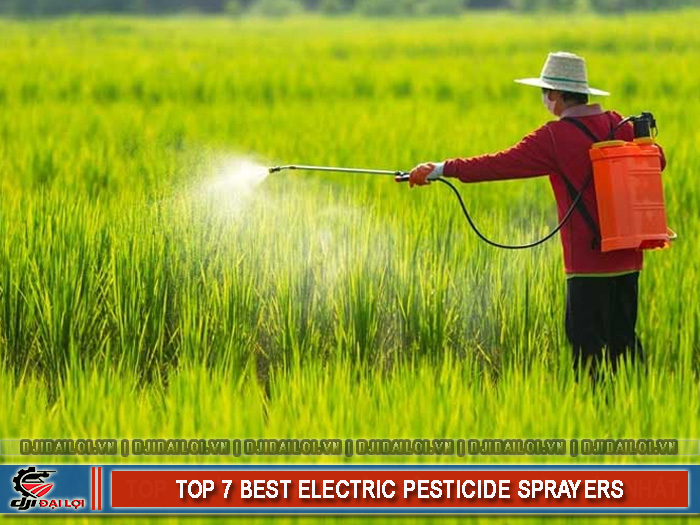
An electric agricultural sprayer uses a battery or accumulator to power the pump, creating pressure that pushes the pesticide solution through the nozzles. Compared to manual or gasoline types, it reduces labor intensity, minimizes chemical exposure, and emits less pollution. In large-scale farming, it can also be paired with agricultural drones to enhance productivity and spraying coverage.
Operating principle
Electric sprayers are preferred for their low noise, cheap operating cost, easy start-up, and enhanced safety. Gasoline sprayers, however, are more suitable for very large areas due to their mechanical durability. For small farms, a 20L dual-pump electric sprayer is an ideal choice. Larger farms may combine these with agricultural spraying drones to increase coverage efficiency across hectares.
Among the many electric sprayer suppliers in Vietnam, Đại Lợi stands out as a trusted distributor that provides genuine products and technical support for leading brands such as Oshima, Motokawa, and Hyundai. Their nationwide service network helps farmers easily access authentic machines, spare parts, and warranty care, ensuring every model performs reliably in real-world conditions.
20L tank, 12V–8Ah battery, approx. 100 PSI, ~4.6 L/min flow rate, 3–4 hours runtime.
20L tank, 12V–12Ah battery, ~7 L/min flow, 80 PSI, only 7.2 kg.
20L tank, dual MS-7100 pump, 12V–12Ah battery, 100 PSI, ~7.2 L/min.
Dual pump, 20L tank, 12V–12Ah battery, ~100 PSI, ~8 L/min.
12V–9Ah Lithium battery, 20L tank. The MK-22Li version reaches 160 PSI and 8 L/min flow.
20L tank, dual genuine pumps, ~8.5 L/min flow, high pressure.
20L tank, 12V–12Ah battery, ~9 L/min flow, ~94 PSI.
|
Model |
Tank Capacity |
Battery Type |
Flow Rate |
Weight |
Runtime |
Strengths |
|---|---|---|---|---|---|---|
|
Oshima Cali 20S |
20L |
12V–8Ah |
~4.6 L/min |
~7.5 kg |
3–4 h |
Good price, easy parts |
|
Motokawa MK-22D Super |
20L |
12V–12Ah |
~7 L/min |
7.2 kg |
5–6 h |
Lightweight, affordable |
|
Mitsu Power 20MS-12 |
20L |
12V–12Ah |
~7.2 L/min |
~7.0 kg |
6–7 h |
Stable, versatile |
|
Hyundai HD-8022 |
20L |
12V–12Ah |
~8 L/min |
~7.8 kg |
6–8 h |
Strong build, dual pump |
|
Motokawa MK-20Li Super |
20L |
Li-ion 12V–9Ah |
~8 L/min |
~7.0 kg |
4–6 h |
Fast charging, steady |
|
Daewoo DAES-S5 |
20L |
12V–12Ah |
~8.5 L/min |
~8.0 kg |
6–7 h |
High pressure, brand trust |
|
Hinota HNT-20BK |
20L |
12V–12Ah |
~9 L/min |
~7.5 kg |
6–7 h |
Cheap, fast spraying |
Summary insights:
Following these steps not only keeps your electric agricultural sprayer working efficiently but also protects user health and the environment.
Routine maintenance can extend lifespan by 1–2 years, reduce repair costs, and ensure accurate spraying dosage.
These electric agricultural sprayers meet diverse needs—from small households to medium farms. Choosing the right model based on area size, spraying duration, and battery type will help optimize cost, improve crop protection, and minimize health risks.
When full, it weighs around 25–28 kg. You can split spraying sessions or use a trolley to ease the load.
Yes. Li-ion batteries are lighter, charge faster, and last longer per cycle, but they’re more expensive.
Dual pumps provide stronger pressure and higher flow, ideal for large areas. Single pumps are more economical for small gardens.
Lead-acid: every 12–18 months; Li-ion: 2–3 years with proper charging.
Online shopping makes price comparison easy, while local dealers offer better warranty and support. Ideally, choose a trusted supplier with a clear return policy.